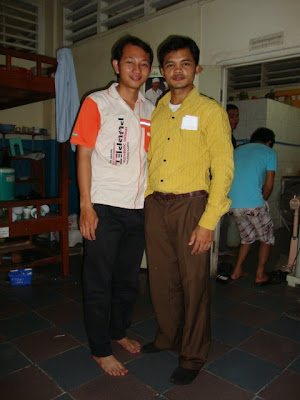Renewable Energy in Cambodia
Outline
¢Overview of Power Sector in Cambodia
¢Potential of Renewable Energy in Cambodia
¢Current situation of RE in Cambodia
¢Government Policy in Rural Electrification
Country Profile
Population 13.4 millions (2008)
Population growth Rate 1.54%
Area 181,035 sq. km
GDP (per capita) 751$US
% of household electrified 20%
Electricity Generation 1,370.618GWh
Electricity Imported 167.414GWh
Peak Demand 205.8MW
¢Solar Energy: the average sunshine duration of 6-9 hours per day, giving an average of 5kWh/day. thus, considerable potential of solar energy. Total installed capacity is around 3,000 kWp.
¢Wind Energy: The southern part of the great lake Tonle Sap, the mountainous districts in the southwest and the coastal regions, such as Sihanoukville, Kampot,Kep and Koh Kong have the annual average wind speed of 5m/s or greater. The total area around 5%.
¢Hydro: The potentiality (10.000MW, but current contribution to electricity production less than 20MW).
§Biomass: The report prepared by NEDO on “the Assistance Project for the Establishment of an Energy Master Plan” identified significant biomass energy resources from a variety of agricultural residues such as rice husk., Cassia, Cassava, Luciana, Coconut, ...
nBiogas: The effectiveness of small scale biogas has been demonstrated in Cambodia by a number of different projects. The use of animal wastes to generate high quality gas for cooking has significant economic, health, social and environment benefits for poor rural households.
nBiofuel: Jatropha – 200 ha (Fencing), Palm Oil – 4,000 ha (recently) and can be 10, 000 ha and sugar cane 20,000 ha.
. Government Policy in Rural Electrification
1.endeavor to provide access to reliable, safe electricity services, with insignificant impact on the environment and at an affordable price for rural communities,
2.provide effective legal, regulatory frameworks and various to a encouragements and train the private sector to participate in providing electricity services by renewable energy in the rural areas,
3.act as a market enabler, through various incentives, for enabling equity in access to reliable and safe electricity services, with insignificant impact on the environment, at an affordable price for the rural communities,
4)encourage the efficient generation, transmission and distribution of electricity using the renewable energy technologies, through tariffs, which are in conformity with the Electricity Authority of Cambodia (EAC)'s regulations,
5)promote electricity systems by renewable energy at least cost for rural communities, through research and pilot development, as part of RGC’s portfolio on grid and off-grid technologies, and
6)ensure adequate resources, appropriate institutional mechanisms and training to empower the poor involving in rural electrification to participate.
Outline
¢Overview of Power Sector in Cambodia
¢Potential of Renewable Energy in Cambodia
¢Current situation of RE in Cambodia
¢Government Policy in Rural Electrification
Country Profile
Population 13.4 millions (2008)
Population growth Rate 1.54%
Area 181,035 sq. km
GDP (per capita) 751$US
% of household electrified 20%
Electricity Generation 1,370.618GWh
Electricity Imported 167.414GWh
Peak Demand 205.8MW
¢Solar Energy: the average sunshine duration of 6-9 hours per day, giving an average of 5kWh/day. thus, considerable potential of solar energy. Total installed capacity is around 3,000 kWp.
¢Wind Energy: The southern part of the great lake Tonle Sap, the mountainous districts in the southwest and the coastal regions, such as Sihanoukville, Kampot,Kep and Koh Kong have the annual average wind speed of 5m/s or greater. The total area around 5%.
¢Hydro: The potentiality (10.000MW, but current contribution to electricity production less than 20MW).
§Biomass: The report prepared by NEDO on “the Assistance Project for the Establishment of an Energy Master Plan” identified significant biomass energy resources from a variety of agricultural residues such as rice husk., Cassia, Cassava, Luciana, Coconut, ...
nBiogas: The effectiveness of small scale biogas has been demonstrated in Cambodia by a number of different projects. The use of animal wastes to generate high quality gas for cooking has significant economic, health, social and environment benefits for poor rural households.
nBiofuel: Jatropha – 200 ha (Fencing), Palm Oil – 4,000 ha (recently) and can be 10, 000 ha and sugar cane 20,000 ha.
. Government Policy in Rural Electrification
1.endeavor to provide access to reliable, safe electricity services, with insignificant impact on the environment and at an affordable price for rural communities,
2.provide effective legal, regulatory frameworks and various to a encouragements and train the private sector to participate in providing electricity services by renewable energy in the rural areas,
3.act as a market enabler, through various incentives, for enabling equity in access to reliable and safe electricity services, with insignificant impact on the environment, at an affordable price for the rural communities,
4)encourage the efficient generation, transmission and distribution of electricity using the renewable energy technologies, through tariffs, which are in conformity with the Electricity Authority of Cambodia (EAC)'s regulations,
5)promote electricity systems by renewable energy at least cost for rural communities, through research and pilot development, as part of RGC’s portfolio on grid and off-grid technologies, and
6)ensure adequate resources, appropriate institutional mechanisms and training to empower the poor involving in rural electrification to participate.
-Content-Introduction to biomass-Source of biomass-Biomass conversion and utilization-Biomass is a renewable source derived from the carbonaceous waste of various human and natural activities.-Biomass fuels include wood, household waste, agricultural crops, raw material from the forest.Types of Biomass-There are four main types of biomass used today: -Wood and agriculture products-Solid waste-Landfill gas-Alcohol fuels.Wood-One form of biomass is wood. Wood waste from sawmills or tree from a forest fire area can be burned to create heat or generate electricity- If the same amount of wood we use for energy is allowed to grow again in our lifetime, it’s a renewable form of energy.Agriculture product-Agriculture residues provide a significant fraction of total nation energy requirement in many developing countries.-Many crop residues often remain partly or wholly unutilized and cause environmental problems.-The residues could therefore meet higher energy demands in the future through more extensive and efficient use..Garbage-Power plants that burn garbage for energy called waste to energy plants.-Making electricity from garbage costs more than making it from coal and other energy source.-The main advantage of burning solid waste is it reduces the amount of garbage dumped in landfills and reduce cost of landfill disposal.Landfill Gas-Landfills can collect the methane gas, purify it, and then use it as an energy source.-Methane, which is the same thing as natural gas is a good energy source-Most gas furnaces and gas stoves use methane supplied by natural gas utility companies..Alcohol Fuels-Wheat, corn, and other crops can be converted into a variety of liquid fuels including ethanol and methanol.-Using ethanol as a motor fuel is nothing new. Its use is almost old as the automobile.-Today ethanol is a high cost fuel

